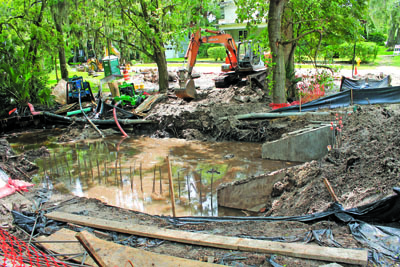Riverside/Willowbranch project progress dampened
Contractor feels rain cloud follows him
By Kate A. Hallock
Resident Community News
Acts of God notwithstanding, residents along Willowbranch and Riverside feel it may take a miracle to complete what has turned into “The NeverEnding Project.”
The construction project was originally proposed under Mayor John Peyton’s administration in April 2009. The intent of the project was to improve vehicular and pedestrian safety of the existing bridge and intersection by bringing it up to current City Standards.

The contractor was finally able to pour concrete in the bottom of the creek, one of the first steps in the process to building retaining walls and doing backfill; according to David Touring, once the rainy weather is past, progress will pick up
According to the four-year-old project presentation, the existing bridge was to be widened by replacing it with a box culvert, which would provide the minimum width needed to construct two 12-foot travel lanes and the required 14-foot safety clearance on both sides of the street. The construction of the project would also improve drainage and traffic functionality.
After awarding the bid to The Touring Company in May 2011 it took nearly a year to get the contract drawn up and approved. The contractor’s plan then was to start after the 2012 rainy season ended and finish the project in first quarter 2013.
“Our original start date of Nov. 28 [2012] was delayed due to the inability to shut off the water main which needed to be relocated. We had to wait well over 100 days to get new valves installed which put us into the rainy season,” said David Touring, president of The Touring Company. “This could have been determined in the planning and design phases.”
Once Touring was able to commence in late March 2013 – eight weeks after he initially thought the project would be completed – he encountered more problems.
“There were two main issues with the project that were considerable. One, the amount of water that flows through the site on a regular basis was not anticipated in the planning and design phases, and two, the cofferdams that were specified were inadequate to withstand the flow in the creek,” Touring explained. “After three attempts to do what was specified, we did contract with a specialty company to install the current cofferdams. The City did not approve this expense (yet), but I refused to put more dirt back in the canal. They [the cofferdams] are working very well.”
Residents in the small condominium at 2936 Riverside Avenue have closely monitored the project, posting photos on their association website and dealing almost daily with City engineers and the contractor. One concern they had was the long-term health of an old cypress tree, whose roots had been exposed through the excavation process.
Arborists with JEA, which is working nearby on St. Johns Avenue, took a look at the cypress tree. “Joe [Anderson] and Mike [Robinson] looked at the cypress trees at the Willowbranch Avenue crossing and saw no issues of concern with the construction,” reported Gerri Boyce, JEA media relations coordinator. “They did not see any major root severances and the tree would have grown with minimal roots in that direction with the drainage ditch and high water levels in the soil.”
The start of the rainy season in late May was the beginning of many project woes. Construction dam blowouts in June, followed by a wetter than usual July, brought new challenges.
Then, last month the City issued a change order and redesign on the project to correct storm water problems down Willowbranch Avenue. According to Touring, that will add a bit of time to the project and will affect the schedule for the pavement.

The contractor was finally able to pour concrete in the bottom of the creek, one of the first steps in the process to building retaining walls and doing backfill; according to David Touring, once the rainy weather is past, progress will pick up
“We are still hoping to complete this project in September, at least the pavement, so we can open the road,” he stated. “Every time we get a hard rain it sets us back almost a week.”
The contractor had to pour concrete into the bottom of the creek before they could move forward with constructing retaining walls. It takes a day to prepare the creekbed [pumping out water], so when it rains they have to start all over.
“This would not have been an issue in November-February,” Touring said. “We did make our first two pours this week [August 19]. Fingers crossed.”
“All that is really important now is that we have identified the issues with the project and we are all working together (City, Engineer, us, etc.) to get this project done,” concluded Touring.






